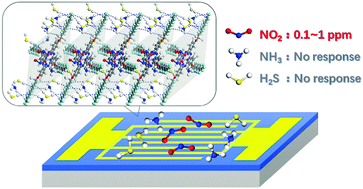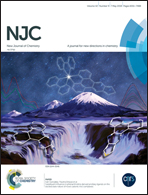Highly selective room-temperature NO2 sensors based on a fluoroalkoxy-substituted phthalocyanine†
Abstract
A new n-type 2(3),9(10),16(17),23(24)-tetrakis(2,2,3,3,4,4,5,5,6,6,7,7,8,8,8-pentadecafluorooctyloxy)phthalocyanine H2[Pc(OCH2(CF2)6CF3)4] (1) is designed and synthesized. The introduction of electron-withdrawing pentadecafluorooctyloxy chains onto the peripheral positions of the phthalocyanine macrocycle successfully realizes the n-type organic semiconducting nature of the compound. Two kinds of films are fabricated by simple drop-casting (DC) and vacuum deposited (VD) methods, respectively. Examination by spectroscopic methods and morphology observation revealed that H2[Pc(OCH2(CF2)6CF3)4] molecules in the DC film adopt the J aggregation mode, whereas those in the VD film adopt the H aggregation mode, with the increasing molecular stacking order of DC < VD films. Moreover, these two types of films are used for low concentrations of NO2 detection. The highly sensitive n-type responses to NO2 gas in the range of 100 ppb to 1 ppm are obtained within a dynamic exposure period of 1 min at room temperature. Depending on the favorable hydrogen bonding between the analytes and the fluoroalkoxy groups or phthalocyanine core of compound 1, excellent selectivity for electrophilic NO2 against electrophobic NH3 and H2S is achieved successfully. The responses of the compound in the DC and VD films are all linearly correlated to the NO2 concentration from 100 ppb to 1 ppm with a significant increase in sensitivity from 7.54% ppm−1 for the former to 12.05% ppm−1 for the latter. The present work not only implies the great potential of the fluoroalkoxy-substituted phthalocyanine derivatives in the field of chemical sensors, but more importantly provides a new strategy through the elaborate molecular design combined with a suitable film fabrication technique to obtain ultrasensitive and selective sensors for the detection of trace amounts of gas.



 Please wait while we load your content...
Please wait while we load your content...